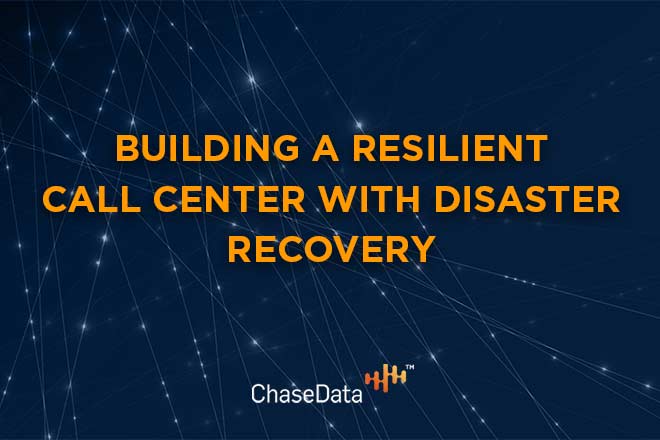February, 13 2020 3:29 pm

No one ever truly plans for disaster. Sure, you can prepare for the worst, but foreseeing the future and the potential for things to go wrong? That’s just not something we can do at this point in history.
That doesn’t mean you can’t ensure that your contact center will be strong in the face of one of these tragedies. No matter what happens, building an effective disaster recovery plan - which takes all possibilities into account - will help you create a resilient call center that can withstand just about anything fate throws at it.
Here is your guide to fortifying your disaster recovery approach so that it will carry you through anything you may face:
Why is it important that your contact center be resilient in the face of disaster? Because you never know when - or what- that disaster might be and how it could potentially impact your business. It could be as reparable as a brief power outage, or as massive as the destruction of your primary facility. Whatever happens, you have to be prepared for it if you hope to continue doing business afterward.
A resilient call center is one that can bounce back from disaster quickly and efficiently - or never be majorly impacted at all. While resilience is important for any kind of business, it is critical for companies who specialize in customer service. When emergencies arise, consumers still have needs to be met; your job as a customer service agency is to ensure that they can still have those needs met, despite what challenges your center might be facing.
This need for a resilient call center is precisely why so many companies invest valuable time and money into disaster recovery plans. Without a plan in place, your business cannot hope to bounce back in the event of an emergency.
One of the primary problems with most disaster recovery plans is that they don’t take a facility’s inherent vulnerabilities into consideration. It is important to plan for common problems, but what are your center’s individual weaknesses in the face of these potential disasters? Evaluating and identifying this is the key component in the successful creation of call center disaster recovery plans.
Another common problem with these plans is that they often do not take staffing into consideration. Yes, it is vitally important to ensure that your center can operate effectively if a disaster of some kind knocks out your phone lines. It is equally important, though, to ensure that your facility has the staff on hand - or operating remotely on your center’s behalf - to handle an influx of calls or even everyday levels of business should an emergency arise. Too many disaster recovery plans fail to identify this as a potential risk and therefore fail to address it.
How can you ensure that your disaster recovery plan has your center covered in all scenarios? Use the following three-step process to create a plan that is certain to work for any situation that might arise:
First, assess your center’s weaknesses and vulnerabilities. This isn’t an easy process; no business owner wants to acknowledge their company’s shortcomings. However, this is the first step in creating a plan that addresses those potential failures and ensures against disaster in the face of emergencies.
How will inclement weather or natural disasters impact your company? Knowing your business’s current vulnerabilities is the best way to evaluate this.
If your center stores everything on-site or operates through traditional servers, for example, a natural disaster that compromises your facility’s property could mean a complete failure for your business. Not having a backup source of energy capable of handling your center’s daily operation for at least several days could also mean disaster, if electrical outages are even remotely possible in your area. Assessing all of this is part of beginning your disaster recovery plan.
Be sure too to evaluate risks that are not technology-based. If your staff is sufficient for an average day you might not have enough for a massive influx of calls resulting from the fallout of a disaster or enough staff members to handle even regular business if half of your staff should be unable to come to work due to inclement weather. Remember to include staffing in your risk identification and management strategies!
The next step of your process should include the actual plotting of your disaster recovery plan. Draw up plans based on your center’s individual needs. Draw from industry recommendations, but focus primarily on what your center requires and the best ways to prevent or bounce back from disaster. Once you identify these best practices, begin training them to all employees and making your disaster recovery plan part of company-wide required knowledge.
To ensure that these plan components are worked successfully into your risk management practices, it is important to regularly assess and review them. This is the third and final step of your plan - the one that starts the whole process over again in many cases. Regularly test employees with drills or simulated scenarios. Make knowledge evaluations a part of your ongoing training efforts. There are so many ways to incorporate these assessments into your disaster recovery strategy creation that don’t detract from your center’s productivity and efficiency!
A resilient call center is one that is equipped with the right tools and technology. Yes, hardware can fail in the event of a disaster, but your software solutions can be your center’s savior. Choosing the right ones is as important for disaster recovery and resilience as it is for ease of everyday operations.
Turn to the industry experts at ChaseData for the best in software solutions. We can help you find exactly what you need to create a more resilient call center and ensure that your staff and equipment are prepared for anything that may happen. For more information, give us a call today!